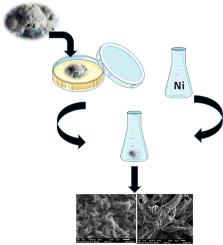Chemosphere ( IF 8.1 ) Pub Date : 2021-05-15 , DOI: 10.1016/j.chemosphere.2021.130871 Rohit Sharma 1 , Teenu Jasrotia 2 , Sonu Sharma 3 , Monu Sharma 3 , Rajeev Kumar 4 , Rajeev Vats 5 , Raman Kumar 3 , Ahmad Umar 6 , M Shaheer Akhtar 7

|
The release of untreated wastewater containing biotoxic substances in the form of heavy metals is one of the most crucial environmental and health challenges faced by our community. The recent advances in microbes derived removal has propelled bioremediation as a better and effective alternative to conventional techniques. Present study investigates the detoxification mechanisms evolved by the nickel (Ni(II)) resistant fungal strains, isolated from the industrial drain sites. The molecular detailing of the isolated fungal isolates confirms their identity as Neurospora crassa and Aspergillus flavus. Laboratory-scale experiments have established influence of different ranges of dose, pH, time, and metal concentration on the removal and uptake trends. Further, the variations in the carbon and nitrogen sources and agitation conditions has revealed the best substratum for achieving optimum results for the industrial exploitation of these microbes. SEM micrographs and FTIR spectra elucidates the superficial alterations on the mycelium of the fungal isolates and the involvement of active functional groups in the bioremediation of Ni(II) respectively. Biosorption of Ni(II) on living biomass has followed the Langmuir adsorption model. The findings of the study have provided a promising insight in the simultaneous action of different mechanistic removal approaches to explore a large scale removal of Ni(II) from the waste generating industries.
中文翻译:

通过新鲜分离的真菌菌株可持续去除废水中的 Ni(II)
含有重金属形式的生物毒性物质的未经处理的废水的排放是我们社区面临的最重要的环境和健康挑战之一。最近在去除微生物方面取得的进展推动生物修复成为传统技术更好、更有效的替代方法。目前的研究调查了从工业排水场所分离的镍 (Ni(II)) 抗性真菌菌株进化的解毒机制。分离出的真菌分离物的分子细节证实它们是粗糙脉孢菌和黄曲霉. 实验室规模的实验已经确定了不同范围的剂量、pH、时间和金属浓度对去除和吸收趋势的影响。此外,碳源和氮源以及搅拌条件的变化揭示了实现这些微生物工业开发的最佳结果的最佳培养基。SEM 显微照片和 FTIR 光谱分别阐明了真菌分离物菌丝体的表面变化和活性官能团在 Ni(II) 生物修复中的参与。Ni(II) 在活生物质上的生物吸附遵循朗缪尔吸附模型。该研究的结果为不同机械去除方法的同时作用提供了有希望的见解,以探索从废物产生行业中大规模去除 Ni(II)。











































 京公网安备 11010802027423号
京公网安备 11010802027423号